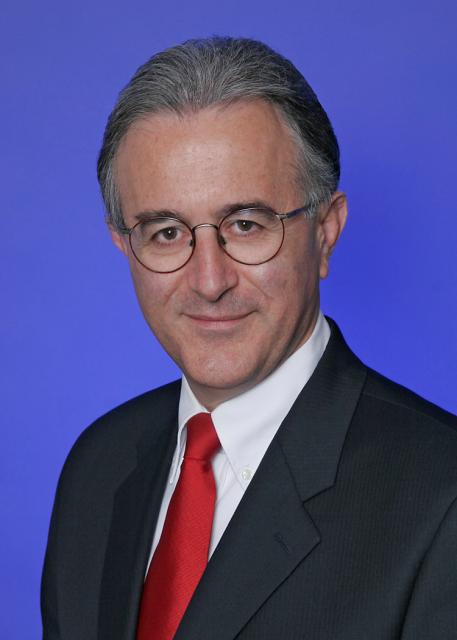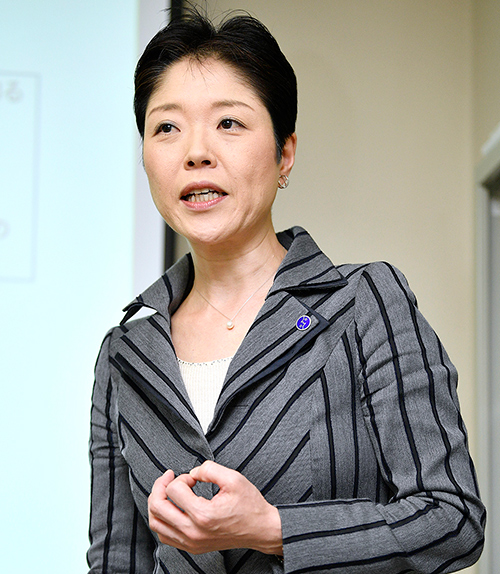July2018 Global Forum
Table of Contents
DIA CHINA 2018
AROUND THE GLOBE
AROUND THE GLOBE
AROUND THE GLOBE CONTINUED
Subscribe
Love Global Forum‘s new online format? Subscribe today and never miss an issue.
Executive Leadership | Editor’s Message
To Our Readers
Global Norming

Alberto Grignolo
Editor
Fellow of DIA
hanks to the emission (and transmission) of knowledge, disagreements are melting and the levels of convergence are rising steadily on the shores of the world.
We are living in an age of remarkable alignment of viewpoints and initiatives in the healthcare product development ecosystem, though much work remains to be done to ensure affordable patient access to medicines (see my June column). The major issues are the same, the conversations are similar, the goals are shared, the approaches differ but are inspired by comparable overarching concerns.
We see evidence of this in the July issue of Global Forum.
Editorial Board
Content stream editors
Translational science
Gary Kelloff US National Institutes of Health
David Parkinson ESSA Pharma, Inc.
regulatory science
Yoshiaki Uyama Pharmaceuticals and Medical Devices Agency (PMDA)
Adora Ndu BioMarin Pharmaceutical, Inc.
Patient engagement
Deborah Collyar Patient Advocates In Research (PAIR)
Lode Dewulf Servier
Value & access
Edith Frénoy European Federation of Pharmaceutical Industries and Associations (EFPIA)
Sean Tunis Center for Medical Technology Policy (CMTP)
Editorial Staff
Alberto Grignolo, Editor PAREXEL International
Ranjini Prithviraj, Senior Managing Editor, Associate Director DIA Publications
Sandra Blumenrath, Science Writer DIA Publications
Chris M. Slawecki, Senior Digital Copyeditor DIA Publications
Regional Editors
AFRICA
David Mukanga Bill and Melinda Gates Foundation
ASEAN
Silke Vogel Duke-National University of Singapore Graduate Medical School
AUSTRALIA/NEW ZEALAND
Richard Day University of New South Wales, Medicine, St Vincent’s Hospital
CANADA
Judith Glennie JL Glennie Consulting, Inc.
Megan Bettle Health Canada
CENTRAL AND SOUTH AMERICA
Jaime Oliveira Bayer S/A
CHINA
Ling Su Shenyang Pharmaceutical University, Lilly Asia Ventures
EUROPE
John Lisman Lisman Legal Life Sciences
INDIA
J. Vijay Venkatraman Oviya MedSafe
JAPAN
Junichi Nishino Novartis
US
Ann Meeker-O’Connell Johnson & Johnson Quality and Compliance
DIA Membership
Bringing together stakeholders for the betterment of global health care.
Genomic and Phenotypic Diaries: A New Model for Patient Engagement
Jeanne Barnett
CEO and Founder,
CysticFibrosis.com,
CFTechnology.org
Alec Pettifer
Director Patient Insights,
CFTechnology.org
Corey Nislow
University of British Columbia
CRC Tier 1 Chair in Translational Genomics
FTechnology.org, a non-profit, global online community of over 18,000 cystic fibrosis (CF) patients and caregivers, has launched a study to begin to leverage the potential benefit of genomic data sharing in the context of this genetic disease. The community was founded in 1996 on the principles of sharing information and putting the patient first, now more commonly addressed as “big data” and characteristic of recent “patient-centric” initiatives.
In response to a 2017 survey, more than 1200 patients and caregivers provided valuable details including their attitudes towards a new technology-based model of patient engagement with researchers and the pharmaceutical industry. Key survey results demonstrate the untapped potential of these patients and caregivers, in partnership with researchers and industry, to effect rapid, positive change:
Pre-Analytics in Individualized Oncology
Stanley R. Hamilton
Head,
Pathology and Laboratory Medicine,
University of Texas MD Anderson Cancer Center,
Houston, Texas
ndividualized oncology, also termed “personalized,” “precision,” “patient-centric,” and “targeted” oncology, is now front and center in both cancer drug development and standard-of-care (SOC) therapy for cancer patients. Individualization is focused on the potential molecular target(s) in each patient’s cancer, with the target used as a biomarker for selection of a drug for that target, or avoidance of its use due to absence of the target. Biomarkers can also serve as indicators of resistance pathways that will render drugs ineffective.
The approach of using a targeted treatment, rather than a next-up tryout of another line of generic, albeit evidence-based therapy, has the intent of improving outcome for patients. The major theoretical advantages are the use of efficacious drugs with better outcomes, fewer adverse events from use of ineffective drugs, and lower cost with higher value for patients. In targeted drug development, identification of a biomarker as a companion diagnostic for each agent has been a required part of the process for many years.
![]() Podcasts
Podcasts
![]() Podcasts
Podcasts
Proceedings: DIA China 2018

Joining the Global Community
DIA China Celebrates 10th Annual Meeting
Joining the Global Community
DIA China Celebrates 10th Annual Meeting
Joining the Global Community
DIA China Celebrates 10th Annual Meeting
Ling Su
Shenyang Pharmaceutical University,
Lilly Asia Ventures
eijing, May 23, 2018. DIA China 2018 marks the tenth anniversary of the DIA China Annual Meeting. Attracting more than 3300 participants from across the globe, including over 370 speakers in more than 80 sessions, this DIA China flagship meeting has become a major multidisciplinary event in the healthcare product development and regulation arena in China.
Since the inception of this annual meeting ten years ago, China’s importance to the global innovation, clinical, regulatory, and healthcare communities has continued to grow. In 2017, the regulatory reform that was started two years ago has achieved significant progress and the Chinese regulatory agency became a full regulatory member of ICH. Also in 2017, the CFDA approved a record number of imported new drugs and received the highest number of innovative new drug applications since 2012.
“We will continue to deepen the regulatory reform,” said Jiao Hong, the newly appointed commissioner of the China National Drug Administration (CNDA, the agency that replaces the CFDA as part of the government reorganization in March 2018), in her speech in the opening Plenary Session. “We will continue to build up an efficient, transparent, and internationally aligned regulatory system to enhance our review quality and efficiency, encourage innovation and improve access of innovative medicines. We will take a risk-based approach and strengthen our enforcement,” Jiao added. She also emphasized that the CNDA will continue to engage in broader and deeper collaboration and exchange with other regulatory bodies around the world and will develop talents who are adaptive to the need of globalization. (Read excerpts of Commissioner Jiao’s speech.)
Also in the opening plenary session, Dr. Sang Guowei, Academician of the Chinese Academy of Engineering and the renowned leader of China’s National Science & Technology Special Program on Innovative Drug Development, reflected on the progress of this program and his participation in DIA activities. He said, “The standards for the development of new drugs in China must be in line with international standards.” He complimented DIA, which has “made important contributions to the promotion of drug development and capacity building in China, as well as the international exchanges.” Dr. Sang had previously been the keynote speaker at the first and fifth DIA China Annual Meetings.
Proceedings: DIA China 2018

Excerpts from China National Drug Administration Commissioner Jiao Hong’s Keynote Address
ver the past 40 years since the China reform, our country has basically solved the problem of accessibility of medicines, and preventive diagnosis and treatment drugs can basically meet the needs of the public.
However, we should clearly recognize, according to international standards as benchmarks, that China’s pharmaceutical industry is not strong enough for innovative capacity, the industrial structure is not yet mature, the degree of industrial concentration is not high enough, and the phenomenon of low-level duplication is still prominent. The level of quality and safety protection remains to be further improved.
Proceedings: DIA China 2018

Innovative Breakthroughs in Oncology Therapy
Current State of Immunotherapies in China
George Liu,
Theme Co-Lead,
Head of Early Development and Scientific Operations,
Harbour Biomed
hile there are already many treatment methods for cancer, advances in basic research have resulted in significant improvements in these treatments, and there are tremendous efforts underway to find novel therapies that can offer even better cancer treatment.
Most recently, immunotherapy as a tumor treatment has come to the scientific forefront because of significant success using immune checkpoint inhibitors and chimeric antigen receptor modified T (CAR-T) cells. The Innovative Breakthrough in Therapy Theme of the 10th DIA China Annual Meeting presented the latest breakthroughs in innovative clinical development in the field of oncology.
Why it matters: With increasing incidence and mortality, cancer has become a major public health problem in China. However, the effectiveness of available treatments is far from satisfactory.
Key Takeaways
- Immunotherapy is one of the most successful treatments for solid tumors. The recent success of immunotherapy, especially anti-PD-1/PD-L1 treatment, is a major step in progressing to better cancer care. Combination therapy has also been widely and successfully used in cancer immunotherapy treatments in recent years.
- Oncology is at the frontline of precision medicines, but still faces many difficulties; one of these difficulties is the lack of predictive biomarkers for treatment response, especially biomarkers based on the unique characteristics of Chinese populations.
- After the 2017 US FDA approval of CTL019, the first CAR-T (chimeric antigen receptor-modified T cells) treatment, CAR-T therapies are developing very rapidly in China. Chinese research scientists have tried a variety of ways to increase the number of T lymphocytes that recognize specific tumors to improve the clinical efficacy of these therapies.
- Recent approval of new therapeutic products such as bispecific antibody, antibody-drug conjugates (ADCs), and Oncovirus, have increased interest in these new approaches. However, each approach presents its own set of difficulties.
Proceedings: DIA China 2018

Clinical Development in China:
Collaboration and Innovation to Address Challenges
Hannah Chen
Theme Lead,
Director, Asia Pacific Strategy Lead, JNJ
he Clinical Development Theme at the 10th DIA China Annual Meeting examined how collaboration and innovation are critical in addressing current challenges in the clinical trial environment in China.
Background
In May 2017, the China Food and Drug Administration (CFDA) issued four new draft policies for public comment in its series of regulatory reforms (which began in 2015) to accelerate the review and approval, and improve the quality, of new drugs and medical devices. In June 2017, ICH and the CFDA jointly announced that CFDA had joined ICH as a Member. “CFDA is continuing to enhance the regulatory standards and regulatory system to promote innovation to improve the drug R&D ecosystem and, ultimately, to improve the access of medicines to patients,” explained Dr. Ling Su in a DIA podcast.
While regulations governing clinical research activities in China have been continuously evolving, the scale, complexity, and cost of these trials have simultaneously and exponentially increased. This explosion of connected factors will require all stakeholders to collaboratively work toward innovative approaches to overcome these and other challenges to innovative clinical research and healthcare product development in China.
Key Takeaways
- Upgrading the overall capability of China’s clinical research system is both essential and urgent; this includes refining hospital infrastructures, systematically providing clinical research education and training to medical doctors, and establishing incentive and performance measures that encourage doctors to conduct clinical research in China
- Qualified clinical professionals and clinical centers are the single greatest success factor in conducting clinical research in China, although effective vendor selection and management is a major influence on clinical operations
- While training to ensure that investigators have a clear understanding of adverse event reporting requirements is important, continuous education and monitoring to help site staff comply with these requirements is more effective
- New technologies and innovative solutions in clinical development can not only provide better experiences for investigators and patients, they can also provide industry and regulator decision makers with more and better information to develop their audit and inspection programs.
Proceedings: DIA China 2018

Medical Affairs and Medical Writing
A Leading Role for Preparing and Submitting Clinical Documents in ICH Member China
Xiaoling Wang
Theme Leader,
Clinical Documentation,
Clinical Science Operation,
Sanofi R&D China
Han Yingying
Medical Writer,
Clinical Science Operation,
Sanofi R&D China
he China National Drug Administration (CNDA, the former China Food and Drug Administration [CFDA]) joined ICH in 2017. This promises more opportunities for clinical development, which makes it important to accelerate the preparation of high-quality submission documents in China. In the Medical Writing Theme of the 10th DIA China Annual Meeting, industry experts from numerous companies shared their experiences to better prepare participants to embrace the opportunities and challenges presented by this new regulatory environment.
Key Takeaways
- Medical writers should begin with the idea of “driving insights into action:” Simple steps on mapping a better review process and managing a disciplined review process can become giant leaps.
- The structure and content of annual Development Safety Update Reports (DSURs) on investigational products can follow ICH E2F; project management by a medical writer is critical to developing a high-quality DSUR.
- Electronic Common Technical Document (eCTD) submission is much more than electronic submission: eCTD implementation will be an opportunity to accelerate new drug approval in China, but also a challenge for industry; early planning and preparation are the keys for success.
- The purpose of preparing and submitting a CTD for clinical documents is to completely and clearly present clinical studies; consider the emphasis points and relationships of Modules 2 and 5 when preparing these documents.
- Collaboration between medical writing and translation teams, supported by artificial intelligence-based machine translation, makes simultaneous document development in both English and Chinese possible and further accelerates cross-regional submissions.
- While regulatory submission guidelines in China are largely harmonized with the ICH, how to maintain high quality submission dossiers across the regions and how to accelerate the preparation process remain critical questions. Medical writers should prepare to embrace rapid technological changes in the future.
Proceedings: DIA China 2018

Safety and Pharmacovigilance
Xue Tang
Drug Safety Unit Regional Head (DRH),
APAC,
orking together to address global health challenges is the key to effective safety monitoring and pharmacovigilance. With increasing volumes of shared data, the field of pharmacovigilance (PV), like many other healthcare areas, is exploding.
Sessions in the Safety and Pharmacovigilance theme focused on safety oversight in clinical trials, post-marketing safety surveillance, labelling across the product lifecycle, pharmacovigilance (PV) information systems, cardiovascular safety of anticancer drugs, and ICH E2 guideline updates.
Proceedings: DIA China 2018

Patient Engagement
Rare Disease Patient Engagement in China Grows, Draws Government Attention
Jane Cai
Theme Lead,
Senior Advisor,
Chinese Organization for Rare Disorders
Former Managing Director,
DIA China
Dayao Zhao
Theme Lead,
Vice President and Lead,
China Drug Development,
Pfizer
he 10th DIA China Annual Meeting precipitated this annual gathering’s first full-day program dedicated to patient groups in China. Through this program, representatives from government, industry, research foundations, medical research institutes, and non-profit organizations, shared recent successes in better meeting the needs of patient (especially rare disease patient) communities in China.
Key Takeaways
- A five-year hospital research study has collected data on approximately 360,000 cases of diagnoses/treatment for 3,560 types of rare diseases in China.
- The National Health Commission (NHC), China National Drug Administration (CNDA), and other government agencies, have published the first official national list of 121 qualified rare diseases, the first recognition of rare diseases on a national level.
- CNDA subsequently released a guidance policy on using overseas clinical data in support of drug filings and approvals to combat life-threatening conditions and rare diseases.
- The first patient group was established in China in 2000; there are now more than 80 rare disease groups promoting research and care for 60 rare diseases in China.
Patient Groups Growing into Bigger Role in China
The first patient group (for hemophilia) was established in China in 2000. Through the leadership of the Chinese Organization for Rare Disorders, the patient community in China now includes 80 patient groups covering 60 rare diseases. In addition to organizational support, CORD has helped leverage patient groups resources and voice patient needs to pharmaceutical companies for clinical trial study recruitment and drug development. CORD also issues financial grants to support further patient group development, patient services, and communication and education programs, and actively advocates for patients in both national and global policy.
Around The Globe
African Medicines Agency Establishment Treaty Adopted by African Ministers of Health
Leveraging Existing Regulatory Assets to Improve Access to Essential Medicines
Margareth Ndomondo Sigonda
Head of Health Programmes,
NEPAD Agency
Margaret Agama-Anyetei
Head of Division Health, Population and Nutrition, Department of Social Affairs,
African Union Commission (AUC)
Gugu Mahlangu
Director General,
Medicines Control Authority of Zimbabwe (MCAZ)
Hlazo Mkandawire
Programme Officer, Communication,
NEPAD Agency
n 19 May 2018, the African Ministers of Health unanimously adopted the draft Treaty for the establishment of a single continental body for the regulation of medicines and medical products, the African Medicines Agency (AMA). Once finalized, the Treaty will be presented to African Union (AU) Heads of State and Government for endorsement in January 2019.
The Ministers of Health convened on the sidelines of the 71st Session of the World Health Assembly (WHA) in Geneva, Switzerland as a working group of the Specialized Technical Committee on Health, Population and Drug Control (STC-HPDC) of the AU. The establishment of AMA will contribute to ensuring that the health of the African people is protected from threats posed by Sub-Standard and Falsified (SF) medicines, medical products and technologies. AMA will also work with the AU to promote the growth of the local pharmaceutical industry on the Continent through its Policy Framework, the Pharmaceutical Manufacturing Plan for Africa (PMPA). PMPA has a clear vision on the development of the pharmaceutical industry in Africa.
![]() Podcasts
Podcasts
Challenges and Opportunities for South Africa’s New Regulatory System
Around The Globe
Driving Regional Regulatory Excellence in ASEAN
Silke Vogel
Associate Professor,
Centre of Regulatory Excellence,
Duke-NUS Medical School, Singapore
Hozanna Ngoh
Centre of Regulatory Excellence,
Duke-NUS Medical School, Singapore
ood regulation promotes better health. A robust health regulatory system enables timely access to good quality, safe, and efficacious health products. At the same time, such a system supports research innovation, encouraging development of health products (including medicines and medical devices) as well as facilitating industry access to market through effective and efficient regulatory processes. These basic principles are relevant and increasingly applicable to the ASEAN region.
Driving Regional Excellence in ASEAN
The Asia-Pacific region is characterized by a diversity of developing, emerging, and developed countries, which is also reflected in the varying levels of maturity and regulatory capacity of national regulatory authorities (NRAs) across the region. Within the Association of South-East Asian Nations (ASEAN), regulatory heterogeneity (i.e., country-specific requirements), inadequate regulatory knowledge and capacity, and the lack of innovation in regulatory science and policy pose significant challenges to NRAs and industry alike. It has been the goal of various international and regional bodies, such as the World Health Organization (WHO) and the Asia-Pacific Economic Cooperation (APEC) forum, to address these capacity issues, although sustaining such initiatives in the long run has proven to be difficult.
Since 2014, the Centre of Regulatory Excellence (CoRE) at the Duke-National University of Singapore Medical School has focused its efforts in promoting regional regulatory excellence in the Asia-Pacific, with a special focus in South-East Asia. CoRE’s strategic approaches include developing education and training programmes, fostering thought leadership, and promoting policy innovation.
In this article, we share two major lessons from CoRE’s experience: (1) partnering to drive sustainable change and (2) developing capacity building programmes that address identified needs.
Around The Globe
Canada Update: Major New Developments on National Pharmacare
Judith Glennie
President,
J.L. Glennie Consulting Inc.
fter years of hints and delays, some visible progress is underway toward a National Pharmacare system in Canada that would provide affordable, insured access to medicines for all Canadians regardless of where the care is received in Canada. But concerns and uncertainties remain.
Background
When the Liberal government took power in late 2015, the Federal Health Minister’s Mandate Letter spoke to a number of initiatives related to pharmaceutical policy. Movement on these issues has been slow, with most initiatives not starting in earnest until 2017 and an expected delivery in the second half of the government’s mandate.
For instance, the federal government joined the pan-Canadian Pharmaceutical Alliance (pCPA) in 2016 to enable federal drug plans to participate in drug pricing negotiations. More recently, there have been proposed changes to the mandate and activities of the Patented Medicine Prices Review Board (PMPRB), as outlined in previous DIA Global Forum updates.
Around The Globe
The Current Middle East Regulatory Environment and Near-Term Future Developments – An Industry Perspective
Greg Jordinson
Associate Director,
Janssen Research & Development UK
Nadine Otin
LEEM, France
Sylvie Meillerais
Director Global Regulatory Policy, MSD Europe
he Middle Eastern regulatory environment continues to evolve as regulatory advancements are made around the world. An important issue regulatory agencies in the Middle East are currently focusing on is broad and timely access to innovative medicines, and how this increased access contributes to the world-wide improvement of quality of life and life expectancy.
Effective, enlightened regulation leads to improvements in healthcare outcomes by speeding access to medicines as well as by enhancing economic competitiveness. Bearing these points in mind, there have been significant and transformational changes in regulatory legislation, accelerating access to innovative medicines in several important countries, for example the introduction of accelerated review pathways (such as Verification and Abridged review processes) in Saudi Arabia, Jordan, and Egypt. Undoubtedly, there are more changes to come as other countries reflect on the changes around them and adopt their own versions of improved regulation.
![]() Podcasts
Podcasts
SFDA Talks Drug Pricing & Shortages
Around The Globe
Raise the Curtain of “Patient Centricity” in Japan
Yoshikata Furuya
Community Leader,
DIA Japan
Patient Engagement Community
ecently, the ideas of “patient centricity” and “patient and public engagement” have been rapidly attracting attention in Japan. At the DIA Japan Annual Meeting 2017 session “Raise the Curtain of Patient Centricity in Japan” an expert in Science, Technology, and Society, a representative of a patient support group, and an expert in clinical studies in a pharmaceutical company shared their opinions and initiatives.

Ikuko Yamaguchi
This article describes the initiative of the Consumer Organization for Medicine & Law (COML), a leading non-profit patient support group in Japan, focusing on its activities of fostering patient and citizen members of healthcare-related committees, through the remarks of COML Board Chairperson Ikuko Yamaguchi.
Community Spotlight
What is the Document and Records Management Community?
Lisa Mulcahy
Mulcahy Consulting, LLC
DRM Community Chair
he Document and Records Management (DRM) Community is focused on documentation management best practices, emerging technology and concepts, architecture, workflow, records retention, multi-purposing of information, and document repositories. The DIA DRM Community objectives, stated in our charter, are to:
- Provide a dynamic forum to encourage professionalism in document management, records management, and information governance through the sharing of knowledge, expertise, and experience.
- Exchange information and discuss current issues related to good document management, records management, and information governance practice.
- Promote good document management, records management, and information governance practices that align with regulatory requirements and expectations of regulatory inspectors.
- Develop supporting materials to assist in the understanding and interpretation of pertinent laws, regulations, and guidances.
- Publish position papers on current issues, new regulations, emerging trends, and technology evolution.
- Influence the regulatory environment as it pertains to the active management and archiving of documentation.
Career Column
The Value of a PharmD Dual Degree
Kaley Weintraub
Rutgers Post-Doctoral Fellow,
Medical Affairs
s the job market becomes more competitive, pharmacy students are seeking early opportunities to ensure they stand out. It has therefore become increasingly popular to pursue additional degrees while completing a PharmD or post-doctoral training. The number of dual-degree programs in the US has increased by about 40% in the last seven years. According to the American Association of Colleges of Pharmacy (AACP), more than 90 schools currently offer PharmD dual-degree programs. These programs include Master of Business Administration (MBA), Master of Science (MS), Master of Public Health (MPH), Doctor of Philosophy (PhD), Doctor of Jurisprudence (JD), Doctor of Medicine (MD), and others.
We Are DIA
DIA Congratulates Our 2018 Inspire Award Winners!
Outstanding Contribution to Health
The BayHelix Group is a non-profit professional organization of business leaders with a mission to shape the growth of the life sciences and healthcare industry.
We Are DIA
Congratulations to Our Two Global Forum Survey Winners!
Thank you for taking the time to share your thoughts and ideas with us. We strive to bring you the information you want, the way you want it.

Tetyana Kolodeznya

Sabita Srivastava

Tetyana Kolodeznya

Sabita Srivastava


Thanks for reading our July 2018 Issue!









